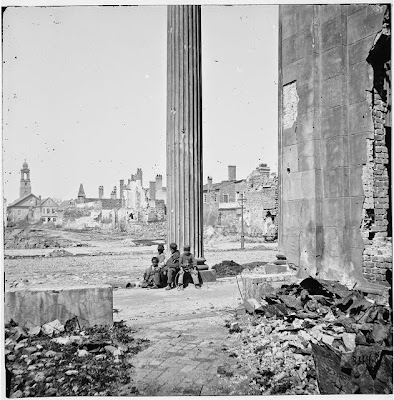 |
| A post-war image of Charleston ladies tending to the graves of the Confederate dead. |
Sunday, May 14, 1865, Savannah Road.
This wounded leg of mine is slowing me down. It is not a serious wound but it is enough to give me trouble. I will rest here along the road and write this while I do. If I should fall asleep, I will not complain.
It is unlikely that I will fame into slumber. This is rice country and the mosquitoes must number in the many dozens of millions.They are worse than Yankee bullets.
Perhaps it would be more accurate to state that this used to be rice country. I have seen, since leaving Charleston, little evidence that any fields of any sort are being planted or tended. While all is peaceful, it is also very haunting. I have encountered a very few people since leaving Charleston. I say no. I have but three days rations hidden away in my pack and it is perhaps six days to home. Not knowing if I can be re-supplied between here and home, I must be frugal.
It was hard to say good-bye to my comrades from the First. Although I have not known them long, they are all first rate. It was probably harder for them to stay than for me to go. Charleston has been devastated much the same as Columbia, maybe worse. Along the Battery, I could see the occasional home that had been struck by Yankee artillery fire.
 |
| Homes along Battery Row, outside the area affected by the Great Fire. This home was damaged by Union artillery fire. |
The greatest damage suffered by Charleston during the war came not from the Yankees but from the same thing that has wiped out great areas of Columbia, fire. Upon seeing the devastated areas, I asked aloud to no one in particular if the Yankees intended to burn out the entire South. McGuire volunteered that there was a great fire that laid waste to the city. A band of destroyed buildings cut Charleston across the middle from river to river.
 |
| Part of the burned out district of Charleston. |
 |
| Interior ruins of St John and St Finbar Church, in the burnt district. |
 |
| Charleston burnt district. |
I found it utterly amazing that for the four years of this war, so much of the destroyed district remained so. For reasons unknown to this poor high private, no repairs or re-construction was attempted. Did the war drain away everything from the home front?
I would have liked to have been able to visit Fort Moultrie but that would have been several miles ut of my way. It was there that I received my first taste of this war with the Star of the West.
 |
| Steamship Star of the West. |
In exchange for something to eat, I surrendered my carbine. It is just as well as I had only six rounds.
If I do not move this tired old body soon, I certainly will fall asleep.
I Send You These Few Words.
In December of 1861, there occurred what became known as the Great Fire of 1861. Sources differ as to the cause and where it started. Some 600 buildings were destroyed and most of them stayed destroyed for the duration of the war.
 |
| Circular Church, in the burnt district. |
 |
Circular Church, April, 2015.
|
 |
| Looking from the waterfront down Vendee Range. Union shells first struck Charleston in this area during the siege in 1863. |
 |
| Same view from the waterfront, April, 2015. |
 |
| The O'Connor House. Union officer prisoners were kept here in the hopes that the Union forces laying siege to the city would hold their fire. News of this led Union authorities to imprison Confederate officers in Fort Pulaski in Savannah. These Confederates became known as the Immortal 600. |
 |
| O'Connor House, April, 2015 |
Tooms did not mention seeing Fort Sumter, or what was left of it. The fort was so shelled by Union artillery that it was never rebuilt to the original design. Its' modern form, after restoration, represents only part of what used to be.
 |
| Fort Sumter before the bombardment. |
 |
| Fort Sumter after the bombardment. |
 |
| Interior, after the bombardment. |
 |
| Sumter today. |
The Star of theWest incident that Tooms referred to involved a Union effort to resupply Fort Sumter from the sea. Confederate artillery at Fort Moultrie fired upon the supply ship, the Star of the West. The effort failed. This occurred in January, 1861, three months before the Confederates opened fire on Fort Sumter in April.
 |
| Sallyport of Fort Moultrie after the siege. |
 |
| Fort Moultrie sallyport, April, 2015. |
Tooms is on his own now. Everyone in the party going from Columbia to Charleston lived in or near Charleston and have no reason to travel any further. They will go home to get their lives up and running again. Tooms is not yet in a position to do this. Tooms will have to be patient and wait until he reaches his home in Beaufort. With that leg of his, he should be there in four days. Five tops.




















No comments:
Post a Comment